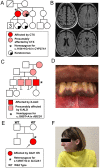NGS-Based Diagnosis of Treatable Neurogenetic Disorders in Adults: Opportunities and Challenges
- PMID: 34066437
- PMCID: PMC8148126
- DOI: 10.3390/genes12050695
NGS-Based Diagnosis of Treatable Neurogenetic Disorders in Adults: Opportunities and Challenges
Abstract
The identification of neurological disorders by next-generation sequencing (NGS)-based gene panels has helped clinicians understand the underlying physiopathology, resulting in personalized treatment for some rare diseases. While the phenotype of distinct neurogenetic disorders is generally well-known in childhood, in adulthood, the phenotype can be unspecific and make the standard diagnostic approach more complex. Here we present three unrelated adults with various neurological manifestations who were successfully diagnosed using NGS, allowing for the initiation of potentially life-changing treatments. A 63-year-old woman with progressive cognitive decline, pyramidal signs, and bilateral cataract was treated by chenodeoxycholic acid following the diagnosis of cerebrotendinous xanthomatosis due to a homozygous variant in CYP27A1. A 32-year-old man with adult-onset spastic paraplegia, in whom a variant in ABCD1 confirmed an X-linked adrenoleukodystrophy, was treated with corticoids for adrenal insufficiency. The third patient, a 28-year-old woman with early-onset developmental delay, epilepsy, and movement disorders was treated with a ketogenic diet following the identification of a variant in SLC2A1, confirming a glucose transporter type 1 deficiency syndrome. This case study illustrates the challenges in the timely diagnosis of medically actionable neurogenetic conditions, but also the considerable potential for improving patient health through modern sequencing technologies.
Keywords: X-linked adrenoleukodystrophy; cerebrotendinous xanthomatosis; glucose transporter type 1 deficiency syndrome; neurogenetic disorders; next-generation sequencing (NGS); treatable diseases.
Conflict of interest statement
The authors declare no conflict of interest.
Figures

Similar articles
-
A 23 years follow-up study identifies GLUT1 deficiency syndrome initially diagnosed as complicated hereditary spastic paraplegia.Eur J Med Genet. 2016 Nov;59(11):564-568. doi: 10.1016/j.ejmg.2016.10.003. Epub 2016 Oct 8. Eur J Med Genet. 2016. PMID: 27725288
-
A Different SLC2A1 Gene Mutation in Glut 1 Deficiency Syndrome: c.734A>C.Balkan Med J. 2017 Dec 1;34(6):580-583. doi: 10.4274/balkanmedj.2016.1376. Epub 2017 Apr 13. Balkan Med J. 2017. PMID: 28443597 Free PMC article.
-
[Clinical and genetic characteristics of glucose transporter type 1 deficiency syndrome].Zhonghua Er Ke Za Zhi. 2013 Jun;51(6):443-7. Zhonghua Er Ke Za Zhi. 2013. PMID: 24120063 Chinese.
-
[Glucose transporter-1 deficiency syndrome can cause various clinical symptoms].Ugeskr Laeger. 2013 Dec 9;175(50A):V04130248. Ugeskr Laeger. 2013. PMID: 25353328 Review. Danish.
-
GLUT1 deficiency syndrome: an update.Rev Neurol (Paris). 2014 Feb;170(2):91-9. doi: 10.1016/j.neurol.2013.09.005. Epub 2013 Nov 20. Rev Neurol (Paris). 2014. PMID: 24269118 Review.
Cited by
-
Identification of the genetic basis of pediatric neurogenetic disorders at a tertiary referral hospital in Indonesia: Contribution of whole exome sequencing.PLoS One. 2023 Oct 25;18(10):e0293113. doi: 10.1371/journal.pone.0293113. eCollection 2023. PLoS One. 2023. PMID: 37878632 Free PMC article.
-
Dietary management and access to treatment for patients with glucose deficiency syndrome type 1: an overview review with focus on the European regulatory framework.Eur J Clin Nutr. 2024 Dec;78(12):1058-1063. doi: 10.1038/s41430-024-01490-0. Epub 2024 Aug 10. Eur J Clin Nutr. 2024. PMID: 39127841 Review.
-
Genetic Testing for Parkinson's Disease and Movement Disorders in Less Privileged Areas: Barriers and Opportunities.Mov Disord Clin Pract. 2024 Jan;11(1):14-20. doi: 10.1002/mdc3.13903. Epub 2023 Nov 29. Mov Disord Clin Pract. 2024. PMID: 38291851 Free PMC article. No abstract available.
-
Whole-exome sequencing in patients with maturation arrest: a potential additional diagnostic tool for prevention of recurrent negative testicular sperm extraction outcomes.Hum Reprod. 2022 May 30;37(6):1334-1350. doi: 10.1093/humrep/deac057. Hum Reprod. 2022. PMID: 35413094 Free PMC article.
-
Eye movement disorders in inborn errors of metabolism: A quantitative analysis of 37 patients.J Inherit Metab Dis. 2022 Sep;45(5):981-995. doi: 10.1002/jimd.12533. Epub 2022 Jul 11. J Inherit Metab Dis. 2022. PMID: 35758105 Free PMC article.
References
Publication types
MeSH terms
Substances
Supplementary concepts
LinkOut - more resources
Full Text Sources
Medical
Miscellaneous

